
Orangeville is a village in Stephenson County, Illinois. The town's sign lists the population at 800 as of January 2021. The population in 2020 was 738. The population according to the 2010 census was 793, up from 751 in 2000. Using the 2020 population of 738 Orangeville is the 741st largest city in Illinois and the 11,650th largest city in the United States. Orangeville is currently declining at a rate of -0.94% annually and its population has decreased by -6.94% since the 2010 census. The area's earliest white settlers arrived in the year 1833, and the village was platted in 1851 by John Bower, who is considered the village founder. In 1867 Orangeville was incorporated as a village. The town's central business district contains several 19th century commercial buildings, many of which were built during the railroad boom of 1888–1914. By the time the Great Depression was ongoing, business in Orangeville had started to decline, with the last bank closing in 1932. In 1956 another bank started operating in the village and is still in town today. Some recent infrastructure jumps have restored some of the village's old decor.

The City and Town Hall in downtown Rochelle, Ogle County, Illinois, United States, operates as the township history museum, holding a number of static displays on local history. Historically it served as the headquarters for city and township government as well as holding the offices of numerous state, local and national entities. The building was erected in 1884 following an 18-year disagreement about the structure's cost between the city of Rochelle and Flagg Township.

The Pine Grove Community Club is a historic community club located at the junction of 1500N and 1300E north-northwest of Paris, Illinois. The club includes two buildings, a brick schoolhouse and a former church. The school was constructed in the late 1800s, while the church was built in 1891. The club itself was established in the early 1930s as part of a community development program in Edgar County. The program, inspired by the Country Life Movement, sought to develop rural communities such as Pine Grove and improve the quality of life of its residents. While the club initially met in the schoolhouse, it purchased the church for its meetings in 1935 after the congregation folded. The club had 40 members in 1935; the number declined to below 30 by the 1960s, though the club still met as of 1983.

The Canterbury Center Historic District is a historic district in Canterbury, Connecticut. The district is centered on the town green, located at the junction of Route 169 and Route 14. It has been the town center since 1705, and includes a fine assortment of 18th and early 19th-century architecture. It was listed on the National Register of Historic Places (NRHP) in 1998.
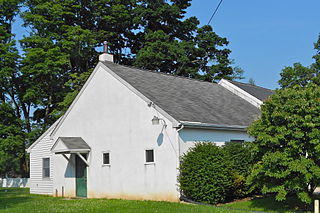
Ercildoun, population about 100, is an unincorporated community in East Fallowfield Township, Chester County, Pennsylvania, United States. The hamlet was founded by Quakers and was an early center of the abolitionist movement. In 1985 the entire hamlet, including 31 properties, was listed as a historic district on the National Register of Historic Places. Of these properties two were vacant land, 14 were significant buildings, ten were contributing buildings, and five buildings, built in the 1950s, were non-contributing. The Lukens Pierce House, an octagon house listed separately on the U.S. National Register of Historic Places, is located about half a mile northwest of the hamlet. Ercildoun is one of about ten hamlets in the township, which has no cities or towns, but has 31 sites listed on the National Register. It is one of the larger hamlets, located near the center of the township, and historically among the best known. The city of Coatesville is about 3 miles north.
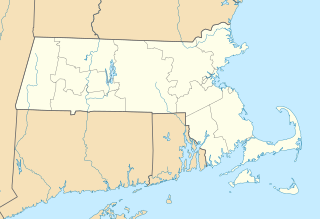
The Ames Schoolhouse is a historic school building at 450 Washington Street in Dedham, Massachusetts. It was originally part of the Dedham Public Schools. It currently serves as the town hall and senior center for the Town of Dedham.

Star Theatre, also known as Partridge Hall, is a shop/meeting hall/theater built in 1878 in Argyle, Wisconsin, in Lafayette County, Wisconsin, United States. It was listed on the National Register of Historic Places in 1980.

The Water Tower was built in 1897 by Challenge Wind and Feed mill Company of Batavia, Illinois. This is a rare wooden tank atop a brick tower type of water tower. Built on a limestone foundation, it is 140 feet (43 m) tall and about 20 feet (6.1 m) in diameter. The brick walls are 2 feet (0.61 m) thick.

The Greenwich Avenue Historic District is a historic district representing the commercial and civic historical development of the downtown area of the town of Greenwich, Connecticut. The district was listed on the National Register of Historic Places on August 31, 1989. Included in the district is the Greenwich Municipal Center Historic District, which was listed on the National Register the year before for the classical revival style municipal buildings in the core of Downtown. Most of the commercial buildings in the district fall into three broad styles, reflecting the period in which they were built: Italianate, Georgian Revival, and Commercial style. The district is linear and runs north–south along the entire length of Greenwich Avenue, the main thoroughfare of Downtown Greenwich, between U.S. Route 1 and the New Haven Line railroad tracks.
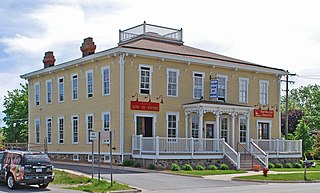
Cherry Hill is an unincorporated community in Canton Township in the U.S. state of Michigan. The community centers along Cherry Hill and Ridge Roads but otherwise has no legally defined boundaries or population statistics. The Cherry Hill Historic District is a primarily residential historic district encompassing the greater part of Cherry Hill. It was listed on the National Register of Historic Places in 2003.

Butler School is a historic building in Oak Brook, Illinois. Frank Osgood Butler donated the land for the two-room schoolhouse in the late 1910s. The building became a meeting place for locals, and hosted the first club to use the term "Oak Brook" to refer to the surrounding settlement. The former school was briefly used as the village hall, police station, and library, until new buildings were constructed for those purposes in the 1970s. It was added to the National Register of Historic Places in 2003.

Democrat Building is a historic building located in downtown Davenport, Iowa, United States. It was individually listed on the National Register of Historic Places in 1983. In 2020 it was included as a contributing property in the Davenport Downtown Commercial Historic District. The historic newspaper building is now an apartment building known as The Democrat Lofts.

The Elk Rapids Township Hall is a former government building located on River Street in Elk Rapids, Michigan. It was designated a Michigan State Historic Site in 1973 and listed on the National Register of Historic Places in 1977. The building was refurbished, and as of 2020, the building served as a rental space and performance venue known as HERTH Hall.

The Warren Township District No. 4 School, also known as the Bunert School, is a one-room schoolhouse building located at 27900 Bunert Road in Warren, Michigan. It was listed on the National Register of Historic Places in 2012 and designated a Michigan State Historic Site in 1989. It is the last one-room schoolhouse remaining in Warren.
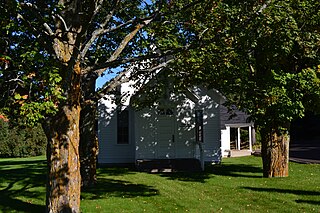
The Bingham District No. 5 Schoolhouse is a school building located at 7171 South Center Highway in Bingham Township, Leelanau County, Michigan. It is now used as the Bingham Township Hall. It was designated a Michigan State Historic Site in 1987 and listed on the National Register of Historic Places in 1991.

The Washington Common Historic District encompasses a cluster of three civic buildings and the town common in the center of Washington, New Hampshire. The town common began as a 2-acre (0.81 ha) parcel acquired in 1787, and the current town hall followed in 1789. It is a two-story wood frame building which originally served as both a civic and religious meeting house. The adjacent Gothic Revival Congregational Church was built in 1840. The third structure is the Schoolhouse, a 2 1⁄2-story two-room school built in 1883. The district was listed on the National Register of Historic Places in 1986.
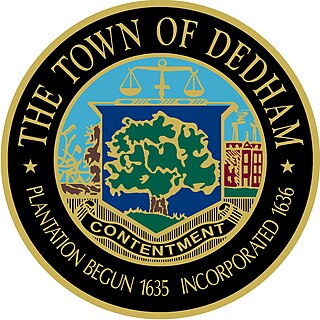
The history of Dedham, Massachusetts from 2000 to present includes several large commercial and residential developments, the Town's 375th anniversary, municipal building projects, and changes to the Charter.
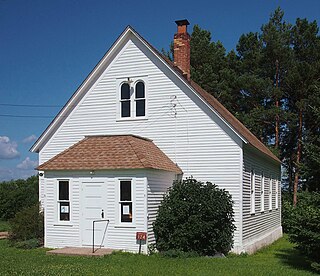
The Cokato Temperance Hall is a historic clubhouse built in 1896 in Cokato Township, Minnesota, United States, to serve as an alcohol-free social center in a rural Finnish American community. It was constructed by a local temperance society at a rural crossroads which became known as Temperance Corner. The building was listed on the National Register of Historic Places under its full Finnish name Cokaton P.R.S. Onnen Toivo Raittiusseura in 1976 for its local significance in the themes of European ethnic heritage and social history. It was nominated for its association with the temperance movement and importance to the cultural life of an immigrant community. The hall is now maintained by the Cokato Finnish American Historical Society, which has moved other historical structures nearby to form the Finnish Pioneer Park.

Cliffwood Hall, formerly Clifton Town Hall, is a historic municipal and social meeting hall at 15 Rebel Hill Road in Clifton, Maine. Built in 1892, it was for nearly 90 years the town's town hall, and one of its principal social meeting venues. It is now home to the Clifton Historical Society's museum collection and is known as the Clifton Town Hall Museum. The Society also operates the Harold Allan Schoolhouse.

The Alpine Elementary School is a compound consisting of four buildings in Alpine, Arizona. The original school building was built in 1930, while the current gym/auditorium was constructed as an LDS chapel in 1939. There are also two more recent constructions consisting of modular buildings, which are not considered as contributing to the historical nature of the site.






















